L.E. Carmichael's Blog, page 13
December 20, 2021
Merry COVID Christmas: On the Value of Traditions in the Worst of Times

The ancient glue that held the stable together finally gave up – but don’t worry. Tech Support can fix pretty much anything.
Last week was tough, you guys. Last week I told a friend I haven’t seen in over two years not to fly out for the holidays, because omicron is blowing up in Ontario and it wasn’t safe for her to come. There was grief, and there was rage. Now, there is mostly the exhaustion that comes with knowing that all of this *waves vaguely at the world in general* could have been avoided.
And yet.
Last week I also opened a box. It was a battered, duct-taped box filled with dust and memories: my mother’s nativity set. She passed away in 2009, and this year, my Dad is passing this tradition on to me.
Ours is a secular household, but this nativity set means so much to me. I remember when Mom bought it – at a Christmas shop in Disneyland when I was about 5 years old. It was big and awkward but she fell in love with it and refused to go home without it. She used to let me arrange the figures when we set it up each December, and I loved that I could change the story by changing their positions. Every piece felt like a friend. And sitting on the floor of my living room, gently unwinding each piece of tattered bubble wrap, I felt the warmth of those memories soothing away the stress of the week, the way Mom’s gentle touch soothed away my childhood fears.
And then Tech Support and I made candy cane cookies.

Two halves of the same heart.
My Mom taught me how to bake, and these cookies are one of the first things I remember making with her. It’s a laborious process. First the dough, half of which gets died red with food colouring before going into the fridge to chill. Then breaking off chunks, rolling them between your palms to form balls. Matching the balls for number and size – somehow it never comes out quite even, but somehow, despite my perfectionist tendencies, that imprecision is part of the delight.
Then a dough ball of each colour under each hand… rolling out into snakes, pressing them together, tapping the ends to make them even, rolling some more. Twisting the snake, and bending it to create the arch – so gently, or the dough will tear. And the scent from the oven as the almond extract aerosolizes – it’s the smell of Christmas. The smell of care, and attention, and love.
Because we’re not done yet – oh no. We still have to wait for them to cool so they can be drizzled with icing sugar glaze and coated in sprinkles. And somehow, there’s always one cookie that gets “accidentally” broken and simply has to get eaten before the rest are packed away in the freezer for Christmas Eve. The look of total innocence on Tech Support’s face when he informed me of this tragedy last night? It was pure joy. As was our discovery that we twist in opposite directions that magically make a whole heart.
And this is how we’ll come through another COVID Christmas. By slowing down and paying attention. By remembering what really matters and working to protecting it. This is how we’ll heal both ourselves and our broken world.
Wishing you joy, and hope, and love.
December 3, 2021
Jean Mills: When “Research” Means Mining Your Own Experience
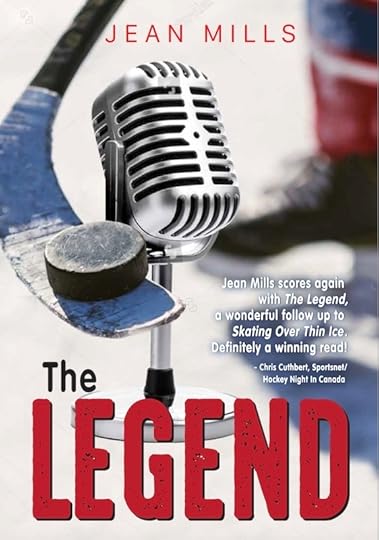 Welcome to Cantastic Authorpalooza, featuring posts by and about great Canadian children’s book creators! Today’s guest:
Jean Mills
. Take it away, Jean!
Welcome to Cantastic Authorpalooza, featuring posts by and about great Canadian children’s book creators! Today’s guest:
Jean Mills
. Take it away, Jean!
“Write what you know.”
Who said that? I’m not sure, but it’s a phrase – an instruction, really – thrown around as a guideline for writers. It suggests you should draw on what you know, mine your own life experience, and be careful leaping into the unknown – or at least no leaping without solid research.
Confession: I’m not enthusiastic about research. I can see my kidlit colleagues throwing their hands up in horror. Research is the fun part for many writers. I’ve heard writers say that research sometimes takes over and they have to force themselves to actually stop digging and get writing.
Not me. When I write a story, I tend to draw on a limited version of that “write what you know” approach, with a few dips into Google or questions thrown out to people with answers. After that, I just leap into the creative abyss and see where my characters take me.
So yes, I used some of my own musical background in the writing of SKATING OVER THIN ICE, a story about a musical prodigy. And yes, I used my little house on the shores of the Northumberland Strait as a starting point for LARKIN ON THE SHORE – but a whole lot of imagination (and leaping) went into the creation of both characters: Imogen, the confused and searching musician, and Larkin, the traumatized and struggling teen trying to find her way to healing. But neither of those characters is me.
And neither is Griffin, the injured hockey player in THE LEGEND, who gets a chance to work in sports media for a local radio station. But you know what IS “me”? Much of the sports media detail included in the story.
That’s because I spent ten years on the Media & Communications team for Curling Canada. I was there watching games from the media bench, interviewing athletes in the post-game scrums, sitting up late in cold arenas or lonely hotel rooms to submit game reports that would be used by other media outlets such as CBC Sports, SportsNet and TSN, not to mention outlets in the United States and around the world. And then there were photographs that needed to be selected, cropped, captioned and inserted into the website. And social media on three platforms (Facebook, Twitter and Instagram) that had to go out quickly during and after each draw, and links to videos of highlights and post-game scrums to be embedded and shared. All before shutting down for the night (somewhere around 2 a.m.) so I could get a few hours sleep before starting it all over again the next morning.
Oh, and no typos allowed, so editing, editing, editing.
It was a grind. It was fun. It was a grind. And I learned a lot.
So in THE LEGEND, when Griffin shows up at the radio station for his interview and is asked to watch a video and write a radio news clip, I knew exactly what he needed to do (and he was a pro, naturally). From there, Griffin ventures into the world of sports media, with a mentor he’s not sure he can trust and some tricky situations along the way. I dug into my own past and, a few times, reached out to media colleagues to help fill in some gaps in order to create a realistic media landscape that readers would enjoy.
For example, Hockey Night In Canada announcer Chris Cuthbert (we were student broadcasters together at CFRC Queen’s Radio many years ago, but that’s another story…) sent me photos from the press box at the Canadian Tire Centre in Ottawa, and he shared some unexpected and colourful details that found their way into the story. Valuable research that enhanced the story.
So here are a few examples of the “write what you know” approach that found their way from my experience onto the pages of THE LEGEND:

The Kreviazuk sisters, Ali (left) and Lynn (right) made interviewing fun, for once. Note the parka I’m wearing. Yes, it was parka weather inside the Maurice Richard Arena in Montreal.
Post-game scrums
I was always nervous interviewing athletes, and with good reason sometimes, especially if someone had just lost a big game. At the 2014 Olympic Trials, the Communications Director (my boss) instructed me to ask a fiercely intimidating male athlete a pointed and difficult question after a loss.
“Do I have to?” I pleaded.
“Yes, you have to,” he said. It turns out, he knew what he was doing.
The athlete clearly didn’t like the question, but he answered well enough, and afterwards, my boss took us aside.
“I told Jean to ask you that question,” he said to the Fierce Curler (who was not happy with me.) “That’s the kind of tough question you’re going to get if you make it to the Olympics. Well done.”
A teaching moment for the athlete; a supportive “I’ve got your back, Jean” moment for me.
In THE LEGEND, Griffin attends a few post-game scrums to interview athletes and coaches. He’s nervous, but he pushes through and makes an impression. (And that’s all I’m going to say about that. *Spoiler*)
Sometimes it was just fun, though. Like the time I got to interview two sisters from opposing teams who had just played against each other.
Protocols
As Griffin discovers in THE LEGEND, working alongside other media professionals is part of the job, and there are protocols to be followed. For instance, during my Curling Canada years, the host broadcaster of our events was TSN, and they had first dibs on access to athletes (especially on the ice), dibs on media bench space, as well as dibs on the selection of donuts provided by Tim Hortons every day. But they were still our colleagues. Working alongside sportswriters from other media outlets meant we all became colleagues as the grind of the competition went on for over a week.
I can state here that CBC Sports media star Devin Heroux saved me when I couldn’t get my phone camera to work (“Just clean it, Jean. Here, I’ll do it.”) And The Athletic’s (then National Post’s) Sean Fitz-Gerald kindly overlooked an unprofessional gaffe from this inexperienced reporter in the post-game scrum and took over the interview when I asked. I learned a lot from my colleagues on the media bench, and I made sure Griffin had his moments with media colleagues, too.

Game over, winners declared, trophy presented, and the national media moves in to get their shot. And that’s me, standing on the side with my phone, waiting for my turn to get a photo for social media. (Can you find me? There, in the middle of the photo, black jacket, holding my phone and waiting my turn. Photo credit: @Chris_Bittle on Twitter)
Social media and storytelling
At various points in the story, Griffin is asked to do social media posts for the radio station, and I confess, this was one of the most fun parts of the job: looking for stories to share. Okay, sharing scores and updates was dull and necessary, but the best part was capturing moments on and off the ice. I was always on the lookout for stories that gave fans a different view of the event. It was all part of storytelling, and maybe explains why I stepped away from this job to focus on storytelling full time – writing fiction for teens, telling stories.

So much happens behind the scenes at a championship event. This was late at night, after the athletes and most of the media had left. I heard a noise and went to investigate. There was Ron, doing the thankless job that needs to be done, alone in a deserted arena.
When writing fiction, research is good, even essential, depending on what you’re writing. I think my own real-life experience contributed valuable insights to the the writing of THE LEGEND. So just maybe, sometimes, “write what you know” really is the best tool for a writer. It works for me.

Canadian champions, after a nail-biter of a game that went to an extra end. Joanne was new to the team this season, her first national women’s title, and she was crying with excitement. I couldn’t resist framing the moment, just a little…
Jean Mills lives in Guelph, Ontario. Her third YA novel, THE LEGEND, was released November 15 by Red Deer Press.
November 19, 2021
Why Can’t All Product Bottles Dispense From the Bottom?
It seems to be Friday again (already), which means I’ll spend tomorrow morning doing what a lot of us do – tidying up the house. Part of my tidying process involves restocking: bringing pantry items from basement storage into the pantry-less kitchen, checking the levels of the personal care products in the bathroom… and transferring the last inch of liquid products from the bottle they came in into a bottle I can actually get them out of.
The amount of time I spend with two bottles and a funnel is, quite frankly, absurd. But you know what else is absurd? Wasting all that product. There was a full month’s supply of Vaseline Intensive Care body lotion that the hand pump couldn’t reach. And because I have both a sense of frugality and a sense of responsibility to the environment, I was not about to recycle that bottle without recovering it.
I mean, it’s not like we don’t know how to make bottles and squeezey tubes that dispense from the bottom – my facial cleanser comes in one. My hair conditioner does not, so instead of letting gravity do the work, I have to give it a firm shake (a dangerous proposition while half asleep in the shower) before dispensing… or figure out how to prop it up on its tiny tiny top, using a dam of other product bottles to keep it from tumbling over in the middle of the night and waking me from a sound* sleep.

So many bottles that don’t dispense from the bottom! Photo is from 2013, by the way. I’ve been working through the stash for a very long time…
Raise your hand if this bugs you, too.
On the upside, I have FINALLY made it down to the very, very last bottle in my Bath and Body Works collection: Twisted Peppermint body wash, which it is almost time to deploy for the holidays. I’m trying to decide if I’m going to store the excess in the aforementioned basement until next year, or simply smell like a candy cane until spring.**
One thing’s for sure – I will NOT be recycling that tippy, slippy, top-dispensing bottle until it’s actually empty.
*hahahaha – like I get those!
**either way, I won’t be buying more. My desire to switch to unscented body products has long been at war with my desire not to waste stuff… which is why it’s taking so long.
November 5, 2021
Karen Autio: A New Story Woven from the Threads of a Classic
Welcome to Cantastic Authorpalooza, featuring posts by and about great Canadian children’s book creators! Today’s guest: Karen Autio . Take it away, Karen!
Thank you, Lindsey, for the opportunity to write this post. It’s an honour to be part of Cantastic Authorpalooza!
All stories are connected,
new ones woven from the threads of the old.
—ROBIN WALL KIMMERER, Braiding Sweetgrass
I used the epigraph above in Making Seaker, my latest book—a contemporary Middle Grade STEM (Science, Technology, Engineering, and Mathematics) novel. Making Seaker was inspired by the iconic book Paddle-to-the-Sea by Holling Clancy Holling, published in 1941, and still in print.
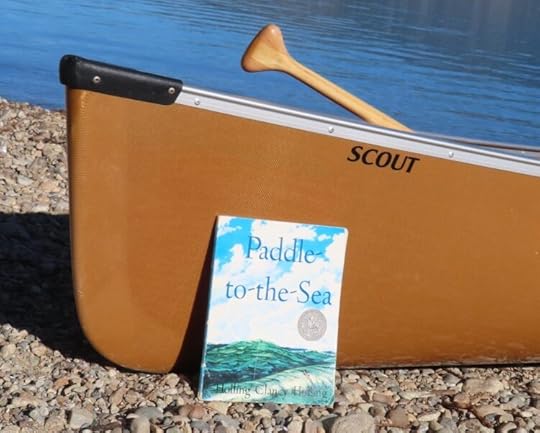
Karen’s well-worn childhood copy of Paddle-to-the-Sea
In Paddle-to-the-Sea, an Indigenous boy carves a small wooden man in a canoe and names the carving Paddle-to-the-Sea (which the author shortens to Paddle). From where the boy sets him on a snowy hill north of Nipigon, Ontario, Paddle is carried by spring runoff down to a creek then swept into the current of the Nipigon River, and eventually floats into Lake Superior. Paddle’s journey takes him all the way through the Great Lakes to the Atlantic Ocean.
When Sumiye Sugawara, librarian at the Nipigon Public Library, asked if I’d write a story set in my hometown of Nipigon and suggested some possible themes, I immediately wanted to link whatever I wrote to Paddle-to-the-Sea.
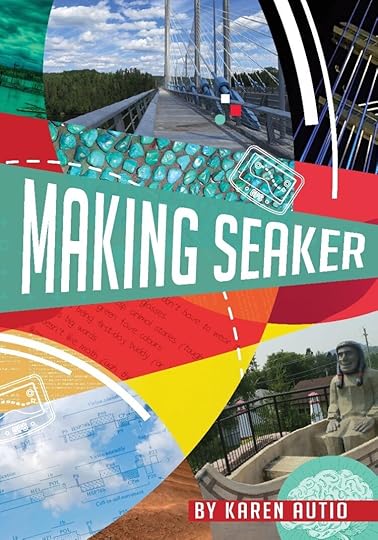 Moving to a new town is tough, especially when you’re different. In Making Seaker, my main character Jamie doesn’t want the friendless future she imagines, so she dreams up a Make-a-Friend project and sets out to be like other kids. But that requires her to deny her love of science, math, and building things, especially models. Her Make-a-Friend project backfires.
Moving to a new town is tough, especially when you’re different. In Making Seaker, my main character Jamie doesn’t want the friendless future she imagines, so she dreams up a Make-a-Friend project and sets out to be like other kids. But that requires her to deny her love of science, math, and building things, especially models. Her Make-a-Friend project backfires.
Following this disaster, Jamie decides to be true to who she is. She likes Nipigon and is fascinated by the Paddle-to-the-Sea story, so she starts a new project, to try making a trackable model boat to recreate Paddle’s journey. After researching the tech she’ll need and searching for the best design for the boat, Jamie reluctantly tells her class about the project. When a classmate offers to help, Jamie is over-the-moon excited. But her STEM project has complications, and so does the friendship. Jamie’s not sure she can salvage either.
In elementary school, we read Paddle-to-the-Sea and watched Paddle to the Sea, the National Film Board short film adaptation created by Bill Mason, released in 1966. I’ve loved Paddle’s story ever since because of its connection to Nipigon, the geography of the Great Lakes, and Paddle’s exciting journey.
After writing Making Seaker, I got to thinking, how else has Paddle-to-the-Sea influenced me?
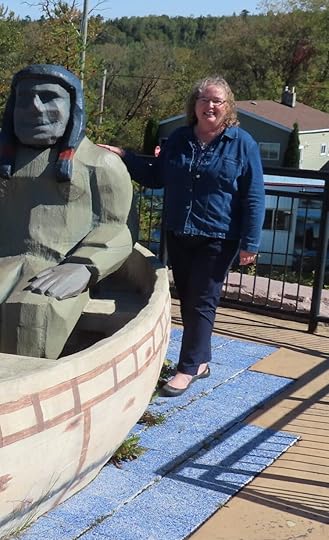
Karen and the statue of Paddle and his canoe in Paddle-to-the-Sea Park, Nipigon, Ontario
For sure the book provided a fun way to describe where I grew up on the northernmost shore of Lake Superior. Holling C. Holling transformed the lake’s outline into a wolf’s head and Nipigon is located near the tip of the wolf’s ear—left ear, to be exact.
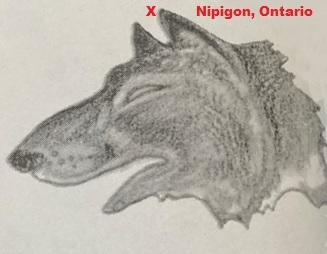
Adapted Image from Paddle-to-the-Sea by Holling C. Holling
A friend recently read Making Seaker and shared that reading Paddle-to-the-Sea in her childhood could be why she has a travel bug. Perhaps that’s why I do, too.
I know the classic book helped develop my love of maps and geography. When choosing my electives for my first year of university studying mathematics and computer science, a geography course was top of the list (and the only one I got A+ in that year!).
More sections of Paddle-to-the-Sea that fascinated me were the diagrams explaining how things work, such as a sawmill, the canal locks at Sault Ste. Marie, and a lake freighter. This led me to explore another title in my childhood home’s collection: The Way Things Work: An Illustrated Encyclopedia of Technology by C. van Amerongen.
Did Paddle-to-the-Sea contribute to my love of paddling a canoe? Perhaps. I thoroughly enjoy my view from the bow of a canoe exploring Lake Superior or Okanagan Lake or any of the numerous smaller lakes near my home in the Okanagan.
I wonder if the book influenced me to write my picture book Growing Up in Wild Horse Canyon as narrative non-fiction, with maps. It could be.
Paddle-to-the-Sea definitely inspired me to write Making Seaker!
I hope my novel inspires readers to explore STEM projects with friends. Or to write their own STEM stories. How wonderful if reading my book leads someone to be true to who they are and follow their own interests despite what others around them may say.
Making Seaker—where classic book inspires contemporary story, and where STEM adventure meets friendship.
To learn more about me and my books, please visit my website or follow me on Facebook or Instagram.
For more information about Seaker, tracking equipment, and Jamie’s real-life science and space inspirations, visit www.seaker.ca
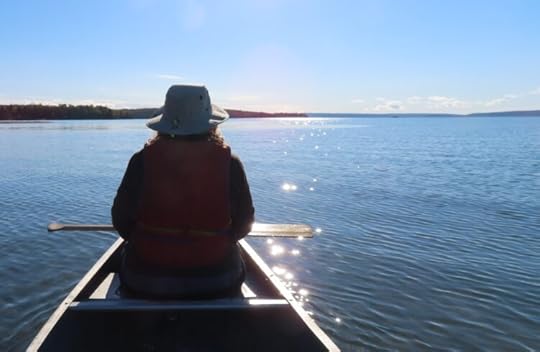
Karen On Lake Superior
October 22, 2021
The Sleep Article For People Who Hate Sleep Articles
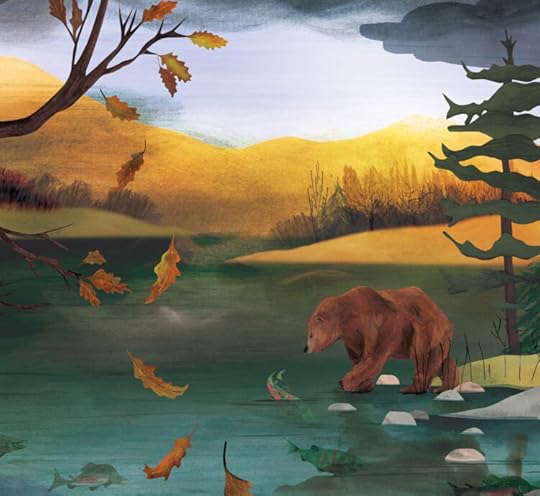
This bear gets better sleep than I do. Art by Josée Bisaillon, from our book, The Boreal Forest
You know those articles about how we should all be getting more sleep? The ones where the first half is dedicated to telling you all the terrifying things that happen to the sleep deprived, and the second half contains completely obvious advice like “drink less caffeine and watch less TV at night?” How about those social media memes about “the ideal length of time to nap”?
I hate those articles. Hate them. Because they’re aimed at people who might actually be able to sleep, if they followed that advice. People who can lie down for a 20 minute nap and spent 19 of those minutes, you know, SLEEPING.
Me? Except for that time in graduate school where the antidepressants knocked me out at the end of every day, I’ve had one nights’ unbroken sleep in my entire life. One, in more than 40 years. Cutting screen time is not going to solve this problem,* no matter how many well-intentioned but mostly-infuriating articles try to shame me into improving my “hygiene,” as if my inability to sleep is somehow my fault.
And it did not help when my new family doctor told me that the long-term side effects of the only-slighly-helpful sleep meds I’ve been taking since I stopped taking antidepressants include increased risks of stuff like fatigue and lethargy and heart disease and Alzheimer’s. You know, the same things you can get as a consequence of… not getting enough sleep.
She did, however, book me for a sleep study – the first one I’ve had in the 17 years I’ve been on said medication. Once I got over the outrage that no other doctor, in three provinces, had thought to do this, I was looking forward to it, because:
a) data and
b) maybe there is a better, more effective, less scary medication I could take instead.
The sleep clinic booked me for 9:15PM, which was already a bad start, because these days I’m looking for my pillow around 8:30. But because I was the last person of the night, the nurse didn’t finish hooking me up until 11PM. I was therefore way too tired to take a selfie, so you will just have to imagine me, in my moose jammies, wires sprouting from my head and legs, belts around my torso to test for chest movements. The wires, in case you were wondering, weren’t long enough for me to assume my normal sleep position – somewhere between side and stomach – which didn’t help. It was a bad, bad night, but that was kind of the point.
Did I mention they woke me up at 5AM? Driving home in the dark was… exciting.
While I wait for the results** I’m back to wondering – where are the articles for people like me? The ones for people who spend their whole lives sleeping like the parents of a colicky infant, with no actual child in sight? The ones that say:
Yes, we know. It’s awful being exhausted every day. Insist that your doctor order a sleep study.
And in the meantime, have that nap. We’re not going to judge how long it takes you.
What about you? Any advice for the chronically sleep deprived? We will try just about anything…
*I know because I’m a scientist: I did that experiment. Absolutely no measurable difference.
** which the nurse said would take a while, in a tone that could have meant anywhere from one month to six…
October 15, 2021
One Weird Trick to Reduce Writing Time
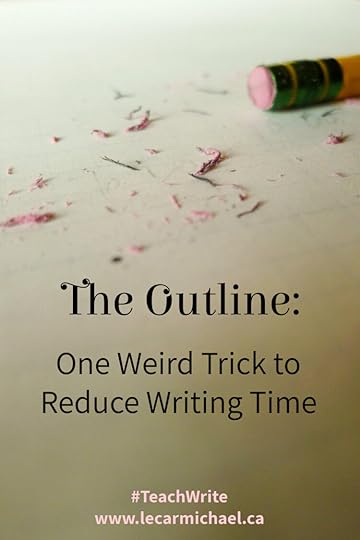 Welcome to Teach Write! This column draws on my 20 years’ experience teaching writing to kids, university students, and adult learners. It includes ideas and exercises that teachers and students can use in the classroom, and creative writers can use to level up their process.
Welcome to Teach Write! This column draws on my 20 years’ experience teaching writing to kids, university students, and adult learners. It includes ideas and exercises that teachers and students can use in the classroom, and creative writers can use to level up their process.
Here we are, well into another school year, and I’m betting quite a few of you are already grappling with writing assignments. So, it seemed like a good time to dust off the old Teach Write column.
I’ve been a writing instructor for more than 20 years now. Want to know the one thing I’ve had the most trouble getting students to do?
Outline before they start to write.
True story. Students — and many professional writers — absolutely HATE to outline. And yet, this one weird trick saves us more time in writing and revision than absolutely anything else. It also dramatically increases the likelihood that our readers — that audience I’ve harped about in many previous columns – will actually have a chance of following our train of thought and understanding what we’re trying to tell them. Which, if we’re students or professionals, is the whole reason we’re writing in the first place.
So, something for us and something for them. Let’s take a closer look at the reasons outlining helps everybody win.
Outlining for Your ReaderWriting is an act of communication – it’s about getting thoughts and ideas and stories out of our brains and into our reader’s. If our thoughts are presented in a logical order, one flowing smoothly into the next, the reading experience is immersive and almost effortless. If our thoughts are jumbled on the page, going back and forth or running in circles, the reader has to work a whole lot harder to understand what we’re trying to tell them. The harder they have to work, the more frustrated and irritated they’re going to get.
If your reader is your teacher, your grade has just dropped. If your reader paid money for the privilege of experiencing your work, the chance of a DNF* just increased. And worst case, they’ll tell their friends not to pay for your writing. Ouch.
I’ve read hundreds of student papers over the years, not to mention the thousands and thousands of other things I’ve read, in pretty much every genre and format there is. Hands down, the biggest barrier to a reader’s comprehension is poor organization. That’s so important, I’m going to say it again:
The biggest barrier to comprehension is poor organization.
Writing isn’t just about figuring out what your reader needs to know. It’s about understanding when they need to know it: at what point during their reading experience is that idea, fact, or dramatic incident going to make the most sense or have the most impact? And, by extension, at what point in the reading experience is that idea, fact, or dramatic incident going to be so confusing the reader tosses your work down in disgust? You know it happens – you’ve probably done it yourself.
So how do we ensure our writing is effectively organized? Well, we can stare at the first draft that we scribbled from the seat of our pants, trying to figure out how to cut, paste, reshuffle, reshape, and re-transition. Or, we can save ourselves a whole lot of time and outline.
Outlining for YouHere are just a few of the ways outlining saves the savvy writer time:
It reveals gaps in your research, supporting evidence, or plot that you can plug before you start to writeIt helps you identify which parts of the material – factual or fantastical – you understand really well, and which ones you don’t. Because if you don’t understand something, you’re not ready to try to explain it to anyone elseIt helps you decide what’s essential and what needs to get tossed out before you waste time writing about itIt helps you figure out the most effective organizational structure for your material (we’ll talk about the many options in a later column)It helps you plan transitions from one idea, concept, or scene to the nextIf Outlining Is So Great, Why Do People Hate It?The two most common reasons people give are:
They had to write a formal, Roman-numeral-laden, three-level outline for school once and the experience was so traumatizing they swore never to outline againThey’re worried that outlining will destroy opportunities for inspiration or creativity during the writing itself.As to the first one, I’ve got good news. The Roman-numeral-trauma-outline is only one of the many ways to get organized before you write. I haven’t used that method since junior high, and in a future column, we’ll talk about the methods – yes, plural – that I rely on instead.
As to the second, set your mind at ease. An outline is not a contract, and there will be no consequences – except time spent – if you break it. You are allowed to change your mind as you go, and in fact, it’s encouraged! It’s a sign that writing is helping your ideas come into even greater focus, which can only be a good thing. If you’re worried, tell yourself this: your outline is the bones. Everything else the bird needs to fly? You’ll add that as you write. You don’t have to decide what colour the feathers will be until the very last draft.
Go Forth and Organize Your WritingI hope I’ve convinced at least some of you pantsters to make outlining part of your writing process! We’ll come back to a lot of these ideas over the next few columns. In the meantime, I wish you clear thoughts and speedy fingers.
* That’s “Did not finish” in Goodreads speak
Hey, did you know I teach writing workshops? It’s true – I work with adult writers, teachers, and students of all ages. Contact me to learn more.
October 8, 2021
Karen Krossing: Sparking Conversations About Emotions with Sour Cakes
 Welcome to Cantastic Authorpalooza, featuring posts by and about great Canadian children’s book creators!
Today’s guest:
Karen Krossing
.
Take it away, Karen!
Welcome to Cantastic Authorpalooza, featuring posts by and about great Canadian children’s book creators!
Today’s guest:
Karen Krossing
.
Take it away, Karen!
Thanks for inviting me to write this post, Lindsey. I’m a fan of Cantastic Authorpalooza!
As an author of novels for teens and kids, I’m used to being the sole creator of a book in partnership with a publishing team. When I wrote my first picture book, part of my journey was to understand and explore this new-to-me format. Picture books are a conversation between author and illustrator, words and art. Each creator brings half a book to form a whole. Co-creating Sour Cakes (Owlkids Books) with talented illustrator Anna Kwan has been a delightful conversation. And conversation is a major theme in Sour Cakes.
I come from a family that talks out problems, perhaps because we’ve faced so many of them. Inspired by my family history of mental health challenges, Sour Cakes is told only in dialogue between two siblings—a big one who wakes up wanting to play and a little one who feels sour. Big tries to cheer Little up by offering to sing a song, colour a picture, and bake sweet cakes, but Little grows increasingly sour. When Little’s mood reaches a boiling point, Big tries a new tactic. She empathizes and enters the gloom with Little, offering compassion and a slice of cake. Together, they navigate Little’s messy feelings until both siblings are ready to play.
When writing Sour Cakes, I drew from my childhood interactions with my older sister as well as interactions between my two daughters and my two nieces. There’s something about siblings—how they can perfectly annoy one another and also support one another with great acts of kindness and acceptance. When illustrating, Anna says she drew from her interactions with her cousins as well as her young nephews, so Sour Cakes is a gift from our families to our readers’ families. Personally, I adore the way that Anna illustrated complex sibling emotions. They can be hard to explain in words, yet somehow Anna has captured them in ways kids can relate to.

Sour Cakes offers a road map for how to acknowledge one’s own difficult emotions and how to support someone who’s experiencing emotions that feel too big to handle. The book can be interpreted as a sibling who is going through a bad mood or a deeper depression. We all experience bad moods and good ones, and it can be hard to navigate them alone. Luckily, we don’t have to.
My goal in writing Sour Cakes was to spark reader conversations about their emotions, so really, Sour Cakes is a conversation that I hope will foster more conversations. For ideas about how to have these conversations, Anna and I created a Discussion Guide and Colouring Pages.
To learn more about me and my books, please visit my website , or follow me on Twitter .
October 1, 2021
And That’s How Two Years Go By
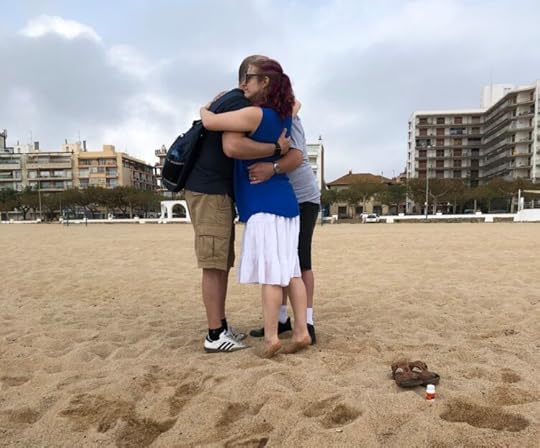
The Carmichaels on the shores of the Mediterranean. The pill bottle next to my sandals contained some of my mom’s ashes, which we released into the sea. Photo by my wonderful stepmom, author Jackie Carmichael.
Two years ago today, I submitted the first draft of my forthcoming children’s book.* I was burned out and already coughing from what would turn out to be a raging case of stress-induced bacterial bronchitis. And I was getting on a plane.
Grandma Hermanson had passed and left the Carmichael branch of the family some unexpected money. We, my brother, my dad, and my not-so-evil-stepmother decided that the best way to honour her memory was to use the money to get together, so we left three provinces and met in Barcelona. Two weeks later, we left Barcelona during a riot.**
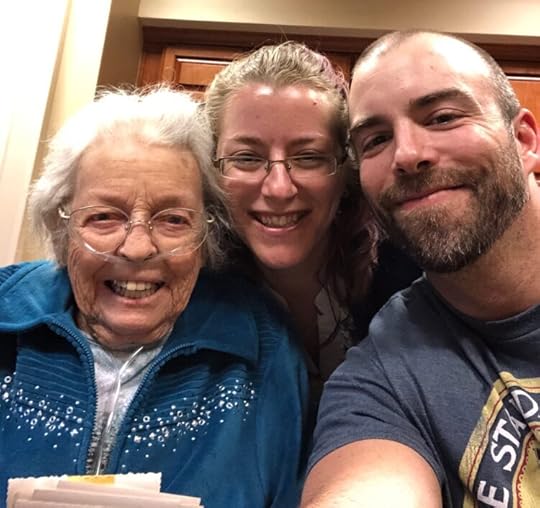
Grandma Hermanson, the last time she saw her Canadian grandkids. That’s my brother on the right.
A month after that, we were on a plane again, because Tech Support’s father was getting remarried.
In January, Tech Support attended a work meeting in the USA. While there, he caught was we assumed was a horrible case of food poisoning, but also kind of looked like a wicked, devastating flu? COVID was something very few people in North America had heard of, and no one believed had anything to do with us.
#Hahahahasob
And that is how two years goes by, somehow taking both a century and no time at all.
I still miss my Grandma desperately, but I am so grateful that she left us before COVID and never had to experience the loneliness and terror of lockdowns in a long-term-care facility. I miss my brother and father and not-so-evil stepmother desperately, too, because see above re: three provinces. And Grandpa Carmichael, who passed this January, and unfortunately did have to experience the loneliness and terror of hospitals during COVID. Shout out to his daughter, my Aunt, who moved mountains to ease his passing when there were no vaccines and it was too dangerous for the rest of us to travel to his bedside.
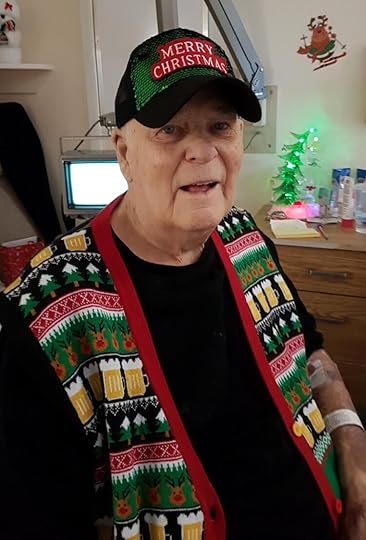
Grandpa Carmichael’s last Christmas.
And now there are vaccines. And my deepest fear is that, because people are refusing to get them, two more years are going to slip right by, taking loved ones and opportunities with them. The tragedy is not the loss – the tragedy is that so much of the loss is preventable.
* Forthcoming in 2023. But I promise, it will be worth the wait!
** No, cheeky monkeys, we neither started it nor participated… unless you count getting trapped on a blockaded highway or sneaking past the barricades at the airport.
September 21, 2021
C is for Climate: Three Ways to Celebrate Science Literacy Week!
It’s Science Literacy Week – woohoo!!!!
For those unfamiliar, Science Literacy Week is an annual event that celebrates the messy, astounding, wonder-filled thing that is the scientific method and all the knowledge it gives us. It’s a time to learn about science, do some science, and – you guessed it – read science books to improve our understanding of what science is and how it works.
It’s a science writer’s favourite time of year.
The theme of Science Literacy Week 2021 is C is for Climate, which works out beautifully, because this year Science Literacy week overlaps with National Forest Week AND National Tree Day! All of which make this the PERFECT time to officially launch the Million Tree Project.
 Here are three ways you can join me in celebrating Science Literacy Week while taking concrete action to fight the ongoing climate crisis.
Here are three ways you can join me in celebrating Science Literacy Week while taking concrete action to fight the ongoing climate crisis.
Especially if you are participating in the Red Cedar Awards this year, because The Boreal Forest is on your reading list! And it’s chock full of both gorgeous art and amazing facts about the world’s largest land biome and Canada’s biggest forest – including the way this forest traps and stores carbon dioxide, slowing the pace of climate change.
Participate in the Million Tree ProjectThe Million Tree Project is a brand new, Canada Wide Experiment brought to you by Science Rendezvous. Its goal is to spark a million conversations about trees and ALL of the things they do for people and the planet. Spoiler alert: slowing climate change is only one of them!
I am super stoked about the Million Tree Project because I am the author of the official Resource Guide for the initiative. The guide is available in print and online. It’s totally free, and it’s jam-packed with both forest science AND practical tips for tree planting. But don’t stop there: check out all the of the additional goodies on the Million Tree Project’s official website, including tree-themed lesson plans written by teachers and aligned with Canadian curricula.
If you’re really digging it (see what I did there?) you can even watch this recording of a virtual presentation I did during our soft launch in the spring. Watch out for sky-diving ducklings!
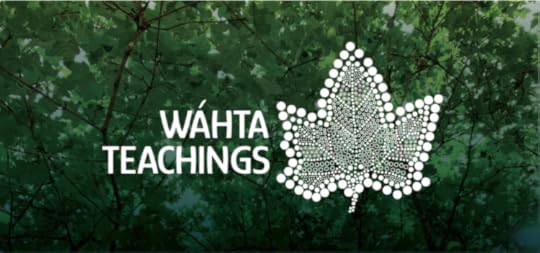 Explore Wáhta Teachings
Explore Wáhta TeachingsWáhta Teachings is also launching this week! This free, multimedia resource places Traditional Indigenous Knowledge and the science of the sugar maple side-by-side, and is also full of cross-curricular information and activities. Working on this collaborative project was an honour and a privilege – to learn more about it, check out this “how-to” video where I tell you all about it! And be sure to hop on over to the website to see if for yourself.
Want More?
Visit the websites for your local universities, libraries, and science centres to see what’s going on. Or check out the Science Literacy Week website for more ideas on ways to celebrate and get involved, this week, and all year round.
September 10, 2021
Sorry For Your Loss: Funeral Customs and Joanne Levy’s Newest Novel
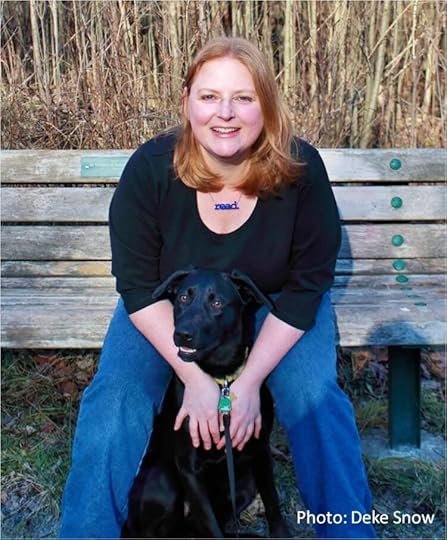 Welcome to Cantastic Authorpalooza, featuring posts by and about great Canadian children’s book creators! Today’s guest:
Joanne Levy
. Take it away, Joanne!
Welcome to Cantastic Authorpalooza, featuring posts by and about great Canadian children’s book creators! Today’s guest:
Joanne Levy
. Take it away, Joanne!
When I wrote SORRY FOR YOUR LOSS, a middle grade novel set in a funeral home, I actually didn’t think much about the science around death. My book is about grief and friendships and what happens to us when we die.
But when I was invited to write a post for this blog, I had something of a lightbulb moment. Lindsey is a scientist, so, of course, I thought it would be appropriate to talk about the science of death and specifically how it relates to my book.
Weird and a bit macabre, I know, but stay with me.
Here is a sad but undeniable truth: everything living must die. Trees and flowers, bumblebees, elephants, and, I’m especially sorry to say, you and me.
But what happens when we die? In my book, SORRY FOR YOUR LOSS, I talk about funerals and funeral traditions, particularly in the context of Judaism. My book isn’t religious, but there are some really interesting details that make a Jewish funeral different than ones you may have attended at a secular funeral home or have seen on TV.
And some of those details mean Jewish funerals and burial are, by definition, eco-friendly. Maybe you’ve never thought about this, which is understandable. Funerals are times of grief and pain—we’re thinking about our loss and not necessarily the impact a funeral might have on our planet. But as we talk more and more about the environment, we need to look at all aspects of how we treat the earth. Including how we return to it.
Here are a few ways that Jewish funerals are environmentally-friendly. I want to stress that these practices are (increasingly) not exclusive to Jewish funerals. So, even if you’re not Jewish, you can still plan a green funeral.
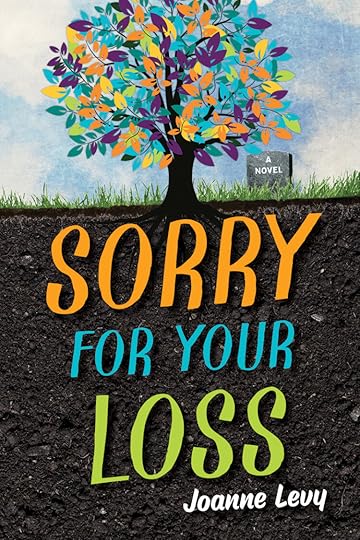 The Jewish way is to return to the earth as quickly and as naturally as possible – that whole dust to dust philosophy. That means no embalming. Embalming is a way of preserving a body, particularly for viewing and extending the time before a body is buried, two things that aren’t done in Jewish funerals.
The Jewish way is to return to the earth as quickly and as naturally as possible – that whole dust to dust philosophy. That means no embalming. Embalming is a way of preserving a body, particularly for viewing and extending the time before a body is buried, two things that aren’t done in Jewish funerals.
In the embalming process, toxic chemicals are put into the body. Not such a concern to the person being embalmed, obviously, but then what happens? Those chemicals leech into the ground after burial.
Since there are no viewings at Jewish funerals, there is no need for makeup, either. In fact, great care is taken to wash the bodies, including removing any makeup and nail polish.
Returning to the earth also means that what you’re buried in makes a difference too. Starting with how the body is dressed. Only natural fibers—linen or cotton—are used in burial shrouds for Jewish funerals. These break down fairly quickly, unlike fibers like polyester and nylon (which are actually plastics made from fossil fuels) that may never break down.
Then there’s the casket*. Jewish practice requires the casket to break down quickly, so they are made of wood. No nails, screws, or metals are used. No concrete crypts, no brass fittings or handles, no steel, nothing that prevents the body from returning to the earth. Renewable, biodegradable materials are used. Guess what that means? Better for the planet.
All this to say that whether you’re Jewish or not, there are many ways to make funerals green. Why not make your final and lasting impact on the planet a positive one? Reduce your eternal footprint, as it were.
If you’ve found these facts interesting, there are even more in my book, SORRY FOR YOUR LOSS. It’s a work of fiction and isn’t only about funerals and death, but I took great care to put in interesting facts about funerals and grant behind-the-scenes access into a funeral home similar to the one my dad manages.
Also, for further reading, there’s a whole page of my research and a discussion guide on my website at: http://www.joannelevy.com/sorry-for-your-loss-research/
I hope you find comfort in the knowing.
*in some places, like Israel, caskets aren’t even used.
To learn more about Joanne and her work, visit her website or follow her on Instagram!



